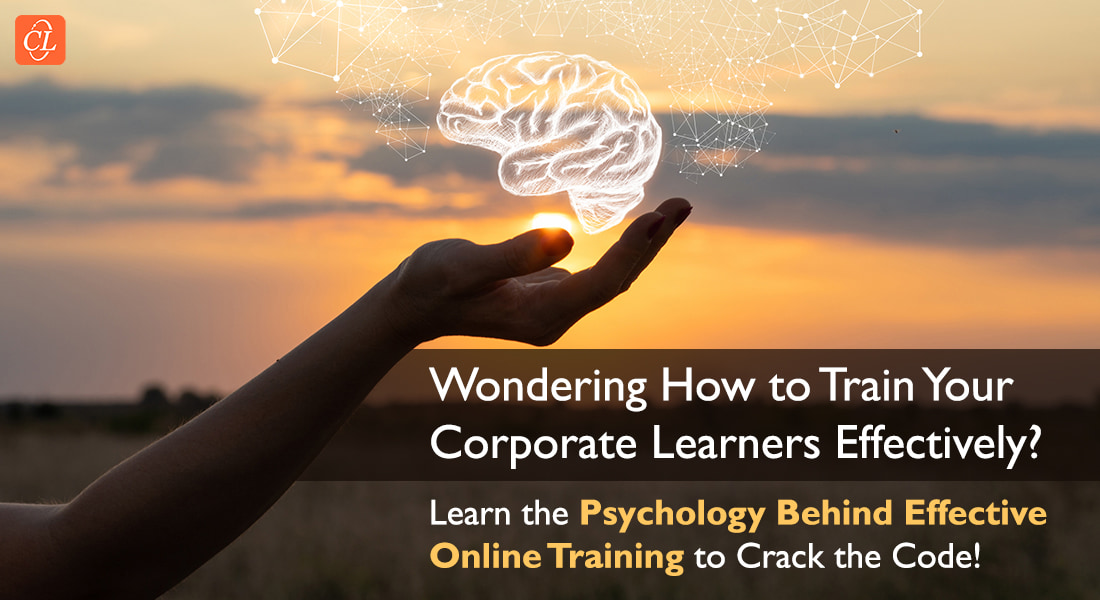How to Leverage the Psychology of Online Learning for Effective Corporate Training

In the current scenario that’s focused on remote and effective learning, online training has become an essential skill to master. This is especially true in the case of organizations that already offer eLearning courses to their employees.
In fact, according to a 2019 LinkedIn report, talent developers have increased their focus on online training by 59% as compared to instructor-led training at 29%. The numbers have only increased owing to the Covid-19 pandemic!
Are you wondering how you can improve the online learning experience in your organization? Let’s find out!
Looking Forward to Understanding the Psychology of Effective Online Training Programs?
Here are the Keys to Adult Learning:
- The need for learning experiences
- The need to relate with previous experiences
- Value addition
- Task centered and life-focused learning
- Recognition of internal motivation
- Cogent reasons to learn
Learn about Online Training for Adults
The first thing you need to be clear about as an online trainer is what adult online training entails. As you’re likely to provide expert knowledge, you must consider the following:
- Know your audience: Find out about your learners’ level of expertise, their learning objectives, and the time they devote to learning.
- Platform of Training: Regardless of the platform that you or your audience utilizes, you need to know how to make the best of it.
- Psychology of Online Training: Classroom instruction and online training are two different avenues. You need to know how to engage your online learners to gain their attention and reduce the drop-out rate.
Learn how you can replicate the benefits of offline learning through online training!
The Science of Adult Learning
To create successful online training experiences, you need to find out about the principles of andragogy, that is, the practice of adult learning.
Self-sufficient
Adult learners are self-directed and independent. Therefore, you need to engage them and help them see their learning as an experience they can connect with.
Experience
Learners draw connections and relevance from their prior experiences. Therefore, your instruction and presentation should be in alignment with their experiences.
Ready to learn
Adults learn concepts and skills they believe they need. Therefore, the online course should add value and relevance to their learning experiences.
Orientation
Instead of learning for the future, adult learners prefer to learn for immediate application. Their learning needs are task-centered and life-focused.
Internal motivation
You need to recognize the internal motivation of adults rather than pushing them to gain external motivation.
Need to know
Adult learners need to know the value of their training programs and you must give them answers on why they need to learn. You can do this by engaging them in a respectful learning environment.
Seven Psychological Pillars of Online Learning
According to recent data from the American Psychological Association (APA), these are the seven pillars that ensure your online training programs stand out.
1. Active Engagement
You can achieve your learning outcomes when your learners are enthusiastically engaged in the training. Here are some active eLearning strategies for you to adopt in your learning programs.
Practice time
Give time to your learners to practice a skill you are demonstrating. Offering feedback on that practice session and its results could be helpful.
Discussions
You need to conduct open discussions with your learners about the theories or skills that are an integral part of the course.
Inquiry
Dive deep into your training material and connect with your learners by inquiring of them and asking questions. This way, learners can connect with the content, as they are compelled to apply their minds and think about what they’re learning.
Problem solving
You must present a challenging scenario that aligns with the topic and ask your learners to find solutions to that problem. Help them get solutions to real-world problems based on the learning objectives.
Active Chats: Make room for active chat sessions and online polls to keep your learners engaged and collaborating with one another.
2. Multi-Learninging Modalities
Multi learning modality increases long-term retention and engagement. Multiple cues and mediums of instruction help your learners improve their recall of training content.
People learn better when provided with both words and pictures rather than when given words alone. Therefore, you can implement multi learning modality in your online course by adding graphics with verbal descriptions. This helps your learners connect with the information through multimedia.
You must make sure the multimedia you use is not too distracting or lengthy. Otherwise, it can shift the focus from the verbal cues that are more important to the visual cues that are only supporting elements.
3. Assessment Strategies
Broader assessment strategies prove beneficial for learners because they help them be more careful and engage with the material. Here are a few assessment strategies you can use:
Tests and quizzes
Tests improve engagement and retention because learners stay focused throughout the course and revisit what they’ve learned.
Self-Assessment
Self-assessment is great for learners who want to save time, but they can also be inaccurate based on the learners’ confidence levels and motivation to learn.
Delayed Assessments
Monitor the behavior and knowledge gains of your learners to assess whether the training has had a lasting impact on them.
Analytics
Collect and analyze the online course’s data, such as learner participation and results. This helps you gain deep insights into the course and how your learners are doing.
Chat Boxes
You need to embed questions into the course through chat boxes or verbal cues so that your learners reflect on their learning at that moment in time.
Opportunity Feedback
You can assess your learners throughout the duration of the course through the analysis of activities such as practice time and problem-based roleplaying. Find out how learners respond to the online course and give them accurate feedback when needed.
4. The Myth of Learning Styles
Each person has a unique learning style, that is, some learn better through visuals, and some are great verbal learners. However, that doesn’t mean visual learners aren’t inclined to learn through verbal content, and verbal learners can surely learn through visual content.
When you use multiple training styles it can allow you to present information in an effective way. This also means you needn’t restrict yourself to a single mode of instruction to suit a particular ‘learning style’ in your audience.
5. Microlearning
Microlearning is an emerging and popular mode of online training, as it’s digestible and each microlearning module focuses on one learning objective.
Most microlearning assets, such as videos, interactive PDFs, infographics, and simulations take less than 15 minutes of the learners’ time. Therefore, it’s not about the modality, rather it involves goal orientation and small bursts of information.
You need to adopt microlearning in your online training program because it helps learners:
- Prepare for a larger training
- Revise training topics
- Update existing knowledge
6. Reinforcement
Most online training programs don’t have an instructor. Therefore, these asynchronous online learning courses need to follow certain strategies to keep learners engaged and motivated. Reinforcements through technical job aids are massively helpful. Here are a few examples:
- Gamification of knowledge
- Learner badges to reinforce progress
- Program direction that gives learners a sense of their progress
- Rewards and a sense of achievement throughout the course
7. Building Connections
The more learners connect with the online training program, the more they can engage with the content and stay motivated. You can connect with learners through storytelling, showcasing examples, and intriguing case studies. Stories and examples add the warmth of human understanding to abstract concepts, and they make them even more appealing to the learners.
Another great way of connecting with learners is to break down complex concepts into small pieces. You can add a layer of connection with your learners by stringing these small manageable pieces together over time.
You can also interweave working examples and problem-solving exercises into your online learning programs. This way, you build better connections especially when training on abstract concepts.
Wrapping it Up
The whole point of online training is to make sure that your learners benefit from your courses instead of throwing information at them they cannot process. The best way to do this is to understand your audience, their needs, and learning styles. Based on psychological evidence, there are seven pillars of retention you need to follow to make your online training even more effective.
Do you want to learn more about online training and how VILT (virtual instructor-led training) courses work? Get this eBook to explore more! Download it now!





![3 Ways to Revamp Leadership Training with Blended Learning [Infographic]](https://blog.commlabindia.com/hubfs/blogs/ways-revamp-leadership-training-blended-learning-infog.jpg)